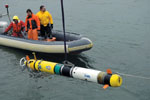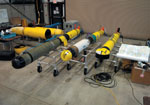Path Forward for Sea Service Leads to Machines Functioning on Their Own
 |
| A REMUS 600 autonomous undersea vehicle configured with a Small Synthetic Aperture Minehunter is brought aboard the TWR 841 following a mission during AUVfest 2008. Mine warfare is one of the current focus areas at the Office of Naval Research (ONR) in its underwater research. |
For centuries, navies around the world have sent sailors over the salty brine to explore and conquer. But as seafarers and their technologies have advanced, knowledge of what lies below the ocean’s surface has become more critical to success. The U.S. Navy has launched numerous projects to enhance underwater capabilities, and some of the most important will reduce the human component of vessels until people are almost absent from the equation.
The Office of Naval Research (ONR) provides the Navy with cutting-edge technology, and many of the ONR’s recent endeavors focus on unmanned, offboard systems for air, surface and underwater use. Offboard systems can stay out in the world on their own, and these platforms, which can serve as force multipliers, are often deployed without a Navy vessel stationed nearby to monitor them. All autonomous vehicles function with minimal human interaction, using computers to run their sensors, their navigation and their operations.
The ONR’s focus on underwater technologies involves the maturation and development of all types of unmanned vehicles. Research is underway to link the various platforms to create a network of the capabilities, with each node in that network having its own role and purpose as well as mission to complete.
The Navy’s interest in unmanned vessels that can stay offboard is both economical and practical. When the fleet is developing an antisubmarine warfare system, using offboard vessels enables the service to deploy more assets because unmanned systems can be mass produced. Autonomous vehicles also enable the service to dedicate more valuable assets, such as humans, to more important functions.
All the plans for unmanned systems hinge on having reliable automation. “You have to have dependable and robust unmanned vehicles or unmanned platforms,” explains Dr. Theresa Palusz- kiewicz, the program lead for physical oceanography and special programs at the ONR. She adds that the Navy is accustomed to using unmanned systems in limited application settings such as mine warfare and battlespace reconnaissance. To send them off to do longer-term, more difficult jobs requires development of the next level of sophistication in their automation, she explains.
Developers of unmanned vehicles not only must create a “brain” to allow the machines to carry out their missions, but they also must determine an ideal size and find an effective power source so the vehicles have enough energy to stay offboard without requiring large battery systems.
For unmanned underwater vehicles (UUVs), the numerous roles are expanding, including antisubmarine warfare, mine warfare and battlespace preparation for tactical reconnaissance of the oceans. These vehicles include both buoyancy and propeller-driven varieties.
Buoyancy craft, also known as gliders, can perform simple missions, such as measuring the temperature and salinity of water. They can carry optic devices and they can be used tactically to support decision aids. Three operational gliders are about 9 inches in diameter, about 6 feet long and weigh approximately 110 pounds. Research gliders are much larger: from 21 inches in diameter and 500 pounds to “the wing,” which weighs more than 1,000 pounds. Smaller gliders travel at approximately half a knot; research gliders swim at speeds up to 3 to 5 knots. Buoyancy is the only type of propulsion used on the vehicles. As do all UUVs, gliders launch from a ship, perform their operations and then rendezvous with the larger vessel.
When personnel deploy an underwater glider, the vehicle will surface to obtain location and send all the data it has collected back to its parent ship, and then it will dive again to continue its objective. The longest mission the ONR has assigned to a glider was seven months. Several weeks is a more common mission time frame. After the predetermined operation, the gliders can arrive at a spot sent electronically to the vehicle or arranged through other means.
Propeller-driven UUVs tend to carry more demanding sensors than those found on gliders, and most of the Navy’s experience with them is in minehunting. Sailors use the vehicles to locate underwater mines while keeping humans away from danger. The UUVs seek out the mines and, after locating them, return to the ships from which they deployed.
These underwater vehicles come in several diameters: 9 inch, 12 3/4 inch, 21 inch and 48 inch. Their lengths vary because most are modular, allowing users to add sections to include sensors. Most powered UUVs travel at 5 knots, but some bigger versions reach speeds of 10 knots or greater.
Powered UUVs recently were used in an exercise off the coast of the northeastern
While underwater, neither gliders nor powered UUVs have contact with the rest of the world. They both resurface to transmit data and to receive retasking information for the next dive.
Paluszkiewicz describes both underwater gliders and powered UUVs as new developments in the Navy’s underwater research efforts, though different generations of the vehicles exist. She explains that developers first establish an operational tool and then transition it to a working level in the Navy. As the sea service becomes comfortable with the technology, researchers begin employing the unmanned vehicles on more sophisticated missions. That step begins the journey to the next phase of autonomous function. “There’s a pathway to the future that includes what we call cooperative behavior,” Paluszkiewicz says.
 |
| Three REMUS 600s in various configurations—from left, a Laser Scalar Gradiometer, a Small Synthetic Aperture Minehunter and the Integrated Precision Underwater Mapping—stand by during AUVfest 2008. AUVfest is a demonstration of 13 AUV systems originally developed by the ONR for minehunting. |
When researchers begin networking unmanned systems, they encounter new science in terms of control theory, optimization theory, communications networking and cooperative autonomy. “Those are all cutting-edge research areas in unmanned systems,” Paluszkiewicz states. “We continue to work the basic unmanned platforms, their engineering, but the big push right now is in autonomy and in these sophisticated behaviors in cooperative autonomy.” The autonomy effort involves making the interfaces between machines and humans more intuitive and putting enough sophistication into the systems so that they become real, working tools for the Navy.
Paluszkiewicz believes that these networks of vehicles are near- to mid-term goals and expects to see some network of unmanned offboard systems around 2015. Informal networks of vehicles exist already. For example, the Navy can send five to six underwater gliders out on a mission together now, but a human is in the loop allocating jobs and positions to the vehicles. “So, they’re directed in their multiple tasks by man,” Paluszkiewicz explains. At the next level of sophistication, the unmanned vehicles will work together without a human instructing them on what part of a job they need to accomplish.
Paluszkiewicz equates this effort in autonomous systems to the use of robots in engineering. “They have these control theories such that they have a whole network of robots that appear to be working in chaos, but they’re just getting the job done most efficiently,” she explains. “They’re communicating with each other saying, ‘I got my part of the job done,’ … That’s where unmanned offboard systems are going.” That kind of sophisticated or intelligent autonomy, that cooperative autonomy, is one of the ONR’s innovation thrusts, Paluszkiewicz adds.
Each medium of autonomous vehicle has specific collaborative technology challenges that developers must overcome. For unmanned aerial vehicles (UAVs), complexities include how to accomplish air traffic control functions without a human systems piece. With unmanned surface vehicles (USVs), the speed at which they travel and the need to avoid collisions with other ships pose challenges for researchers. But UUVs present the most difficulties because robots under the water have a hard time talking to each other.
Paluszkiewicz explains that it is easier to communicate with a Rover sent to the moon or Mars than it is to communicate with vehicles underwater. “If robots can communicate easily, it’s still a difficult job because it’s a control theory and an optimization job,” Paluszkiewicz says. Scientists have experience with those problems in processes such as cell phone routing and manufacturing. “But when things can’t talk to each other, when there’s a lag in the communications, then that’s an engineering difficulty,” she shares. Because of those communications problems, offboard underwater vehicles will talk infrequently and in the equivalent of short sentences. This means they have to be smarter about the type of information they exchange.
The ONR is conducting other research regarding autonomous offboard systems beyond networking them, though most of that work is classified. However, Paluszkiewicz does say that the technologies used in mine warfare, antisubmarine warfare and battlespace reconnaissance could apply to other problems in the Navy’s realm.
One of the most advanced areas of unmanned vehicles right now, according to Paluszkiewicz, is in minehunting. “You can see the appeal of using an autonomous system for hunting mines,” she says. “It’s a dangerous and time-consuming task.” By training the autonomous systems to do the work, the pressure is taken off humans, and ideally more area is cleared in less time. “So the mine warfare problem is one in which the systems are more advanced than anywhere else,” Paluszkiewicz explains. And though the mines are underwater, the systems used to combat them could soon be high in the air. The ONR is starting to build programs that use UAVs in antisubmarine warfare. UAVs are primarily sensor and surveillance systems and can have evolving roles as developers build more sophisticated network systems.
Paluszkiewicz describes mine warfare and its future with cooperative behavior as one end of the UUV spectrum. The other end lies in battlespace sensing. The part of the Navy responsible for the environment uses a fleet of gliders to conduct environmental sensing. Paluszkiewicz says that part of the sea service is beginning to build its capabilities and expects interesting developments over the next couple of years. The Navy will learn more about its operational environment because it will have a different look at it than ever before. “With a network of sensing systems that are giving them timely information, they’ll be able to make more skillful decisions on where to place equipment,” she explains.
Web Resource
Office of Naval Research: www.onr.navy.mil



Comments